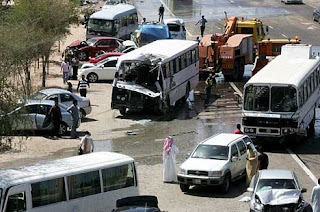Introduction:-
Accidents are the most common cause of death. Accidents happen, even to people who are careful, but many accidents may be avoidable if simple precautions are taken.
careful, but many accidents may be avoidable if simple precautions are taken.
The number of cars on the roads is continually increasing. Roads are generally safer than they were, with the exception of occasional poor design, poor maintenance and speed bumps, which may damage tyres/steering/suspension and may contribute to accidents, particularly for motor cyclists. Cars are much safer for occupants with seat belts, air bags, advanced breaking systems, electronic stability control and published crash ratings. However, safety for pedestrians still lags behind.
Speed:-
Excessive driving speed contributes to 28% of collisions in which someone is killed and 18% of those resulting in serious injury. Every year people are killed because drivers are travelling too fast. Drivers must be aware of their stopping distance. Adverse road conditions and a heavily laden vehicle also increase braking distance.
Alcohol And Drugs:-
Alcohol impairs judgement. There is impairment of reaction times, co-ordination, concentration and judgement of speed, time and distance. Some people also become over-confident or aggressive. The drivers medical conditions also impair safe driving.
people also become over-confident or aggressive. The drivers medical conditions also impair safe driving.
Mobile Phones And Driving:-
Research has shown that using hand-held or hands-free mobiles phones whilst driving increases the risk of the driver crashing, injuring or killing themselves and/or other people by four times.A law came into force making it an offence for drivers to use a hand-held mobile phone whilst driving.
Motor Cyclists:-
Motor cyclists are extremely vulnerable and represent 21% of all road fatalities. Compulsory crash helmets have had benefit. Proper motor cycle leathers contain some body armour but this is still trivial protection compared with the body of a car and the stability of 4 wheels.
Cyclists:-
Cyclists are killed or injured in reported road in urban areas. Cycle pathways can give some benefit to cyclists.
Road Accident Prevention:-
(i)Do not park on pavements. This puts pedestrians at risk by increasing their need to walk on the road and can also damage the pavements, also affecting pedestrian safety.
pedestrians at risk by increasing their need to walk on the road and can also damage the pavements, also affecting pedestrian safety.
(ii)Broken down vehicles should be moved off the road if possible. Hazard warning lights should be switched on and a high visibility jacket should be worn if available.
(iii)Speed: Be aware of your speed when you are driving. Watch your speedometer, know the limits, concentrate and slow down when you are entering villages.
(iv)Drugs: Medicines that may have side effects that affect ability to drive should be clearly labelled. People should not drive under the influence of elicit drugs.
(v)Do not use hands-free or hand-held mobile phones whilst driving.
(vi)The correct seatbelt or child restraint should always be used.
Accidents are the most common cause of death. Accidents happen, even to people who are
 careful, but many accidents may be avoidable if simple precautions are taken.
careful, but many accidents may be avoidable if simple precautions are taken.The number of cars on the roads is continually increasing. Roads are generally safer than they were, with the exception of occasional poor design, poor maintenance and speed bumps, which may damage tyres/steering/suspension and may contribute to accidents, particularly for motor cyclists. Cars are much safer for occupants with seat belts, air bags, advanced breaking systems, electronic stability control and published crash ratings. However, safety for pedestrians still lags behind.
Speed:-
Excessive driving speed contributes to 28% of collisions in which someone is killed and 18% of those resulting in serious injury. Every year people are killed because drivers are travelling too fast. Drivers must be aware of their stopping distance. Adverse road conditions and a heavily laden vehicle also increase braking distance.
Alcohol And Drugs:-
Alcohol impairs judgement. There is impairment of reaction times, co-ordination, concentration and judgement of speed, time and distance. Some
 people also become over-confident or aggressive. The drivers medical conditions also impair safe driving.
people also become over-confident or aggressive. The drivers medical conditions also impair safe driving.Mobile Phones And Driving:-
Research has shown that using hand-held or hands-free mobiles phones whilst driving increases the risk of the driver crashing, injuring or killing themselves and/or other people by four times.A law came into force making it an offence for drivers to use a hand-held mobile phone whilst driving.
Motor Cyclists:-
Motor cyclists are extremely vulnerable and represent 21% of all road fatalities. Compulsory crash helmets have had benefit. Proper motor cycle leathers contain some body armour but this is still trivial protection compared with the body of a car and the stability of 4 wheels.
Cyclists:-
Cyclists are killed or injured in reported road in urban areas. Cycle pathways can give some benefit to cyclists.
Road Accident Prevention:-
(i)Do not park on pavements. This puts
 pedestrians at risk by increasing their need to walk on the road and can also damage the pavements, also affecting pedestrian safety.
pedestrians at risk by increasing their need to walk on the road and can also damage the pavements, also affecting pedestrian safety.(ii)Broken down vehicles should be moved off the road if possible. Hazard warning lights should be switched on and a high visibility jacket should be worn if available.
(iii)Speed: Be aware of your speed when you are driving. Watch your speedometer, know the limits, concentrate and slow down when you are entering villages.
(iv)Drugs: Medicines that may have side effects that affect ability to drive should be clearly labelled. People should not drive under the influence of elicit drugs.
(v)Do not use hands-free or hand-held mobile phones whilst driving.
(vi)The correct seatbelt or child restraint should always be used.







